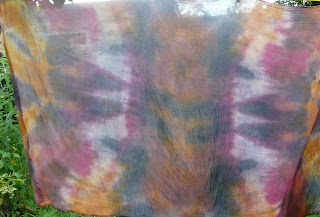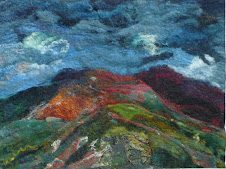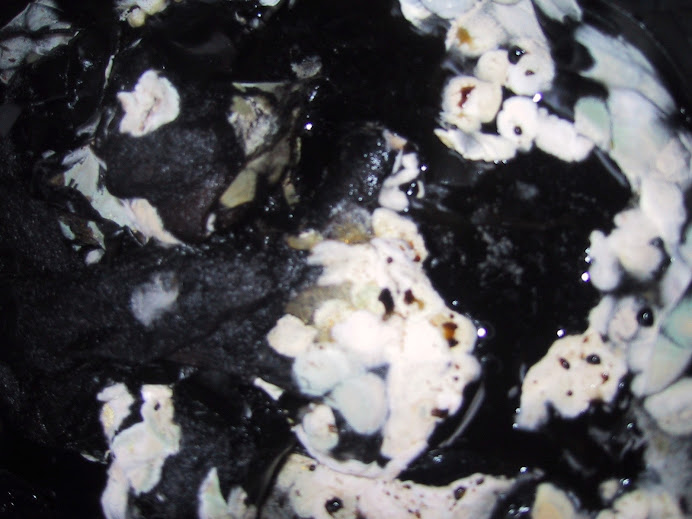.Maiwa's blog describes how you need to scour -ensure that fabric is free of all natural oils and grease before dyeing-the conventional view. Cotton needs a prolonged boil with washing up liquid and washing soda, silk just a gentle wash in washing up liquid to remove dressing and wool a scour with washing up liquid either cold or hot depending on your preference. .India Flint on her blog as she often does takes an original and thought provoking point on the issue of scouring
India points out that Japanese mordant methods which features many dips with drying in between before starching and says ...".and if it's so strongly attached to the cloth that you have to boil it off with dangerously strong chemical assistants then you might as well leave it there......"
hmm
but then it is not starch added after mordanting being removed by boiling cotton in washing soda and washing up liquid it is the natural oils in the cotton being removed so you can mordant.
Do we need to remove the oils from cotton? The sericin from silk and the lanolin form wool?
.Anything which has been washed a lot is going to be okay for dyeing and DOH! stupid of me - the point that India has made that washing powder often contains sodium carbonate which will act as a mordant had not occurred to me. So well washed cottons linens and silks may not need scouring or indeed mordanting. You can check for the first with cotton by dropping a drop of water onto a dry cotton. If the water beads the cotton contains natural oils and so the water does not penetrate. If it goes flat and soaks in the cotton contains no oils.
My thoughts are like this:
If water cannot penetrate new cotton then nor will the mordants or dyes .
Many years ago when I first I tried dyeing cotton with natural dyes I was very disappointed at the pale patchy colour. Then I discovered JN Liles The Art and Craft of Natural Dyeing. It was a light bulb moment for me and an "aha! That's what I am doing wrong" . He emphasised the importance of preparation and tells you how to prepare all natural fibres. by scouring.
When I read the two blogs more carefully I realise what I had thought was a debate about scouring was two people talking (mostly) about two different things. Maiwa about ridding new fibres and fabrics of oils etc and India Flint mostly talking about using recycled fabrics and washing silk (which had previously been dry cleaned) However her point that her steaming of bundled fabrics really pushes the dye into the fibre is something really worth worth thinking about and trying. All the fabric bundling I do is is setting the dye over a long period with solar heat.
As I said
Interesting
Provided you are natural dyer :)
Incidentally I go into scouring in all my dye books Currently on offer with 20% off on my website (Till the end of January) but both blogs are worth reading for more on the subject. And India Flint's Eco Colour is one of the great classics of the natural dyeing world.
Muslin and silks on the line.
Soup a la Julienne
-
This is a vegetable soup which is quick to make up and surprisingly
delicious. It could easily be served with fried snippets, or bread
triangles fried ...
2 weeks ago





























interesting subject... 'to wash or not to wash'...
ReplyDeleteThanks Trica nice to know you find it interesting too>
ReplyDeletethank you Helen for adding to the discussion[s]...and your point about water penetration is most sensible.
ReplyDeletecuriously i've found that some oils can contribute to dye take-up. eucalyptus oil for example can act as a deepening agent when euc leaves are bundled together with other leaves - on the other hand, it's also a recognised cleaning agent.
as you pointed out, there is a huge difference between dyeing with plants and dyeing with synthetic dyes - having left the latter behind years ago i tend to overlook them these days. you'd be quite right in suggesting that new cloth should be scoured before the application of any synthetic dyes.
I find this also very interesting, although I haven't dyed cotton at all and very little on silk, so my only experience is wool.
ReplyDeleteIn my experience if the lanolin (or most of it) is left in the wool before dyeing, the mordant and dyes attach to it, which in itself would be ok, IF you never wash the wool again (actually I wash my woollen things very seldom, once in a year or two, so for my own sweaters I wouldn't be so concerned, but someone else might wash more often, and with heavier soap/detergent). Then when you wash the wool, some (or even most in worst case) of the color comes off with the lanolin, and the color is not fast.
But my experences are only from chemically untreated wool and from natural lanolin, so I find other opinions about other fibers interesting, it could be different with them.
Hi India thanks for your comments. I am interested in your comment about Eucalyptus oil. The other thought that came to me was in dyeing cotton turkey red a long complicated process is carried out to oil the cloth usually I understand with stale caster oil although this is not my area of expertise- However you still start with scouring the cotton.
ReplyDeleteI know very little about synthetic dyes as I only use natural dyes but my experience of natural dyeing is that you need clean scoured fibres and fabrics for good results and I agree with you Leena dyeing greasy wool results in dye washing out with the oils.
I found your blog from the Postcard blog and am so excited to read all your wonderful information. I loved seeing the plants and reading about the new links that I know will be on my reading list.
ReplyDeleteHi Pat that is very exciting as I find the postcard blog fabulous too!
ReplyDeleteHi Helen, been meaning to reply for some time but been a bit sidetracked recently. Your water drop penetration test for cotton sounds sensible/logical. But I found something curious with prima, a fine cotton specially for batik because of its superb smooth surface. It's prepared for dyeing (therefore oils etc taken out) and so should be OK to go straight in the vat without scouring. But tests show that boiling can remove something yellowish. And so I wonder, is that remnant oil or some treatment to make the surface smooth? Makes me apprehensive to now not first scour it!
ReplyDeleteI once read about the commercial treatment for removing oils etc, it doesn't sound very pleasant at all.